Travel Tips
Discovering the Himalayan Mountains: Bhutan Travel Guide
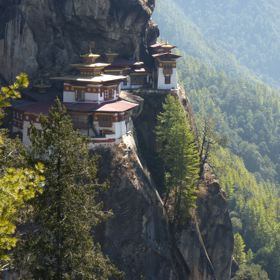 Highlights of any visit to the Kingdom of Bhutan must include the many Dzongs and Goembas (ancient fortresses and monasteries) strategically positioned on high on mountain cliffs or at the confluence of mighty rivers.
Highlights of any visit to the Kingdom of Bhutan must include the many Dzongs and Goembas (ancient fortresses and monasteries) strategically positioned on high on mountain cliffs or at the confluence of mighty rivers.
And much has been written about them.
Ann Morfogen shares her discoveries, from natural wonders to surprising meals to shopping lessons, within this remote Himalayan nation.
NURTURING BHUTAN’S NATURE
The Bhutanese are serious about their environment and it shows. Much of the landscape is still pristine, with close to 60 percent being protected land or stunning Himalayan mountain ranges.
Royal Society for the Protection of Nature (RSPN), headquartered in a charming old house in a back street in Thimphu, Bhutan’s capitol, advises the country in the areas of environment, conservation and sustainable tourism.
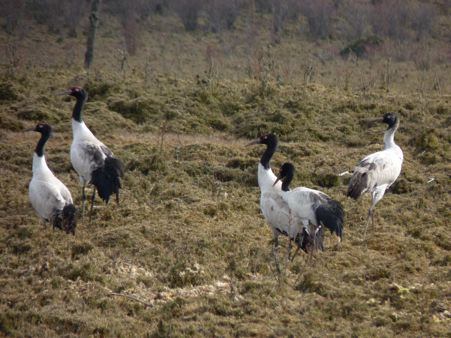 Through the Society, my travel companion and I were able to arrange a special visit to see the endangered black-necked cranes that nest in the winter months in the Phobjikha Valley in the middle of Bhutan (elevation 9,800 feet).
Through the Society, my travel companion and I were able to arrange a special visit to see the endangered black-necked cranes that nest in the winter months in the Phobjikha Valley in the middle of Bhutan (elevation 9,800 feet).
There are about 322 cranes in the valley from November to March (and not very many more around the world). The number is now being impacted by a local leopard that enjoys living—and dining—in the same valley.
The birds arrive each fall from Tibet, and the locals consider them sacred, believing they represent the journey of the Buddha over the Himalayas.
The cranes are majestic, several feet tall with an enormous wingspan. Watching them lift off effortlessly into the mist on the upward currents of wind and spiral high in the air at sun rise, is a magical experience.
If you’re a birder, try Birding in Belize on an Independent Shore Excursion.
The RSPN’s Crane Center in Gangtey is a small round building outfitted with powerful telescopes and binoculars and a panoramic view of the entire valley. It is a short walk out on the spongy marshland full of small bamboo shoots, a favorite food of the cranes, to get a closer view.
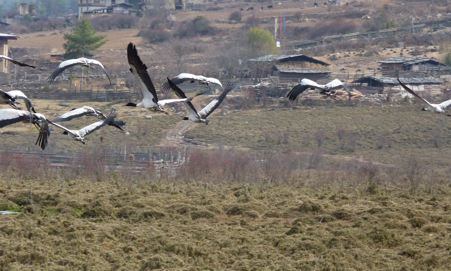 But the real treat is seeing and hearing the cranes (they are noisy) circling high above the colorful 16th century Gangtey Goemba, and watching the monks pour out of the building to stare up at them in wonder.
But the real treat is seeing and hearing the cranes (they are noisy) circling high above the colorful 16th century Gangtey Goemba, and watching the monks pour out of the building to stare up at them in wonder.
With its multitude of high mountains, deep valleys, and powerful rivers, hydroelectric power is Bhutan’s most valuable revenue generator. RSPN has been working closely with the local communities on the environmental impact of hydroelectric power, but it is impossible not to notice and even be a bit bothered by the many trucks on the road to Wangdue—the result of the dams and a giant plant (the Puna Tshanchu project) being constructed up river.
There is great concern that all of this will impact the local white-bellied herons, of which there are only about 35 in the world.
For travelers, it is best to get past the clutter of Wangdue and enjoy the scenery and pleasures of Gangtey, or of the Punakha Valley. For birders and trekkers, this part of Bhutan is truly a paradise, with hundreds of species, pristine trails, and many outfitters well-equipped to help plan a great adventure amidst trees and plants of all varieties and colors.
For more birding adventures, try Birding in South Africa with “Soft” Adventure Travel & Safaris.
Beyond the birds there are, of course, the elusive and also endangered snow leopards that live high in the mountains, as well as the sturdy and not particularly attractive—but very amusing—yak grazing on the hilltops.
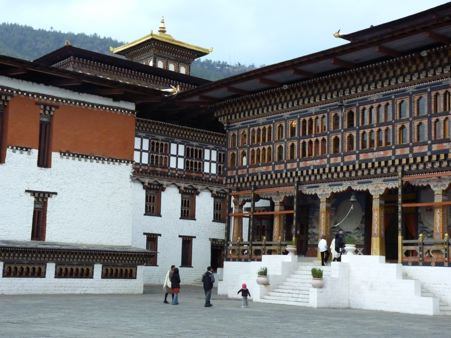 DINING LIKE A LOCAL … YAK, ANYONE?
DINING LIKE A LOCAL … YAK, ANYONE?
In many countries around the world, markets are where you really begin to connect with the local people and culture, and Bhutan is no exception. The markets are a kinetic mix of sights and smells, fruits and vegetables of all sizes and colors, and a meeting place for the local community.
However, the weekend market in Thimphu (Friday, Saturday, Sunday) has been modernized with nondescript stalls and roofs, and while you will see produce of every kind—including the agonizingly hot chili peppers that permeate every dish—it is simply not as charming as the Sunday market in Paro.
Paro market is held in an open field filled with families—mothers, fathers, children, grandparents— shopping for their weekly supplies. Everyone is smiling and friendly, confirming the fact that the gross national happiness (GNH), the measure by which the Bhutanese government encourages people to evaluate their lives, can be far more meaningful than the GNP.
Learn more about Bhutan’s young leader, Jigme Khesar Namgyel Wangchuck, in this slideshow: President’s Day: The World’s Hottest Leaders.
The Bhutanese diet is rich in yak: milk, butter, cheese and, of course, yak meat. Most meals are based on rice from the terraced hillsides with yak cheese and hot chilis.
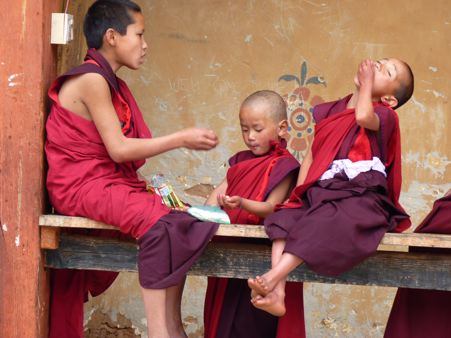 Depending on whether it is breakfast, lunch or dinner, or a more elaborate meal, you might get a little meat, chicken or fish. Yak stew is interesting, the local yak burger not really, and the yak carpaccio is worth a pass. Just remember, the Bhutanese like their food very hot, so keep your rice and water bottle handy.
Depending on whether it is breakfast, lunch or dinner, or a more elaborate meal, you might get a little meat, chicken or fish. Yak stew is interesting, the local yak burger not really, and the yak carpaccio is worth a pass. Just remember, the Bhutanese like their food very hot, so keep your rice and water bottle handy.
The local buckwheat pancakes are worth trying, as is the local honey. Not only does the honey taste different in each town, but its color varies as well. The same is true of the local fresh yoghurt, and they are all well worth comparing.
We experienced a traditional Bhutanese lunch in the dining room of the Jumolhari Hotel, with a wonderful view of central Thimphu and the Clock Tower Square.
Don’t miss Ann Morgofen talking about her experience on Peter Greenberg Worldwide Radio in Bhutan, the Virtues of Tourism & Rhode Island Chefs.
Other dining options include the Seasons Restaurant, farther up Norzim Lam road from the Jumolhari, which is the place to see tourists and expats, and serves a good pizza for those in need of a Western fix. The dining rooms in the various Aman resorts in Bhutan serve both Western and Bhutanese food of the highest quality.
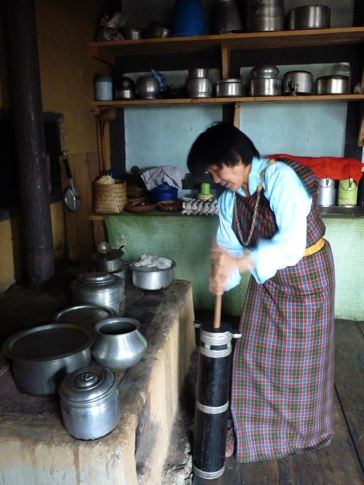 If you’re looking to go beyond the tourist scene, try dining in a local home to experience a typical family meal. Bhutanese people tend to be very welcoming, and it is easy to have your hotel concierge or tour operator arrange visits to homes for tea, lunch or dinner.
If you’re looking to go beyond the tourist scene, try dining in a local home to experience a typical family meal. Bhutanese people tend to be very welcoming, and it is easy to have your hotel concierge or tour operator arrange visits to homes for tea, lunch or dinner.
We visited the home of Am Daw Zam, next door to the Gangtey Goemba, where we shared in the preparation of butter tea, made with bitter local tea and freshly churned yak butter. The result: a murky brown and very salty brew.
Truth be told, we preferred the puffed rice with yak butter and the puffed corn, both traditional snacks, and left our tea behind. But the experience was fascinating, from the small kitchen (which doubled as the bedroom for the family), to the small receiving room filled with colorful traditional fabric, to the prayer room, which was the most elaborately decorated in traditional paint, fabric, and artifacts.
Take a trip that’s easy on the Earth: visit our Eco-Travel section.
CULTURE, CLOTHING AND ARTS
Unlike many other developing countries where the locals are often wearing jeans, T-shirts and sneakers, the Bhutanese are encouraged to wear their traditional clothes—and they do.
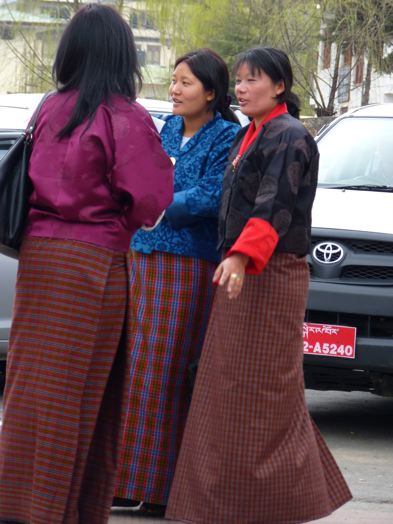 Young and old, men, women, school children, all costumed in attire that can only be found in Bhutan. The men wear a gho, which looks like a bathrobe with wide contrasting sleeves and a collar, and high socks. The women wear a colorful kira, comprised of a short jacket and long skirt.
Young and old, men, women, school children, all costumed in attire that can only be found in Bhutan. The men wear a gho, which looks like a bathrobe with wide contrasting sleeves and a collar, and high socks. The women wear a colorful kira, comprised of a short jacket and long skirt.
The fabrics are usually stripped, in shades of brown, blue, green and purple. But there are also incredibly beautiful hand-woven fabrics, and ceremonial garments that literally belong in museums.
In addition to the weaving, which is taught in schools to preserve the tradition, there is also a tradition of painting that reflects both the history of Buddhism and of Bhutan, and is prominent in every Dzong and Goemba, old and new. The paintings, called thangkas, can be massive, and are rich with color and story. Both painting and weaving are art forms being preserved through a variety of state-sponsored schools, primarily in Thimphu.
Probably the most efficient overview of both crafts and shopping takes about 90 minutes in central Thimphu. All within walking distance of each other are: the Folk Heritage Museum with its authentic view of how people lived over 100 years ago; the National Institute for Zorig Chusum, which teaches young artists to paint in the traditional style; the National Institute for Traditional Medicine, with every herb and bug imaginable; and the Sangay Arts and Crafts shop, with a decent representation of traditional crafts.
Learn much more about the region with our category devoted exclusively to India & Central Asian travel.
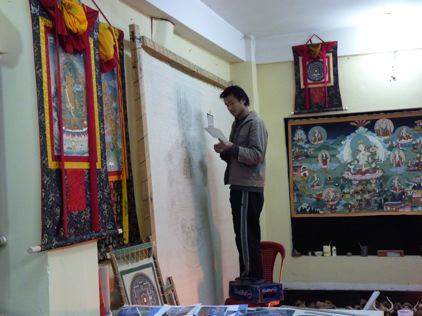 Not far from there down the road is the Textile Center, while a 10-minute drive across the river and up a hill are two shops that offer both insights into the culture and the opportunity to bring a little of it back home: the Jungshi Handmade Paper Factory and Shop and the Thangka Painting Gallery run by Mr. Pema Tshering, with its fabulous new thangkas, old and new textiles, and the opportunity to commission something local to suit your own taste.
Not far from there down the road is the Textile Center, while a 10-minute drive across the river and up a hill are two shops that offer both insights into the culture and the opportunity to bring a little of it back home: the Jungshi Handmade Paper Factory and Shop and the Thangka Painting Gallery run by Mr. Pema Tshering, with its fabulous new thangkas, old and new textiles, and the opportunity to commission something local to suit your own taste.
There is also a growing contemporary art community with outposts in both Thimphu and Paro. But before you shop it is wise to visit the National Museum up the hill from the Paro Dzong. It has a fantastic collection of old thangkas, old Buddhas, and wide variety of artifacts dating back to the earliest days of Bhutan.
After that, a visit to a gallery like Vajrayana Art just off the main road in Paro will have much more meaning. Ms. Sangye Ome, the gallery manager, is extremely helpful, and as with all the Bhutanese we encountered, quite willing to share information on artists and follow-up later through email.
Need destination advice? Check out our Ask the Locals Travel Guides.
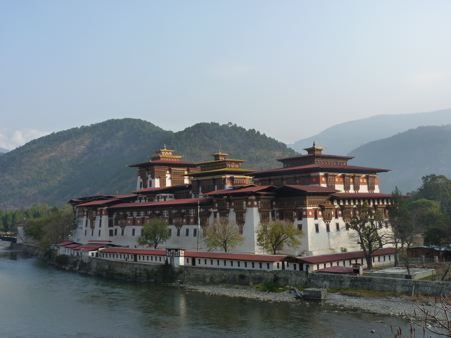 Also in Paro, the Aman hotel features carefully curated art exhibitions. Brazilian photographer/painter, Heloisa Oliveria’s “Visions of Cham” series of graphic photos capturing the traditional black-hat dances of the monks in Trongsa is positively surreal.
Also in Paro, the Aman hotel features carefully curated art exhibitions. Brazilian photographer/painter, Heloisa Oliveria’s “Visions of Cham” series of graphic photos capturing the traditional black-hat dances of the monks in Trongsa is positively surreal.
As for shopping for textiles and art, there is not much opportunity outside of Thimphu and Paro. No matter where you are, take care that what you are purchasing is from Bhutan, and not something shipped in from Nepal or India.
The Aman gift shops in both Thimphu and Paro offer a well-edited selection of high-quality locally produced merchandise at a variety of price points. Compared to many items in the local stores, both the prices and the quality seem better.
Though geared toward tourists, the National Handicrafts Emporium, with outposts in Thimphu, Paro and Bumthang, offers a wide-range of well-priced traditional crafts.
Yuesel Handicraft on the main Paro Road (shop #16) offers very interesting work. Yangphel Ceramics, located next door to the Zhiwa Ling Hotel on the main Paro road, features unique hand-painted and glazed ceramics of very high quality, and something not seen anywhere else in Bhutan.
And our personal favorite, the very sweet and low-key Souvenir Production Training Center on the road heading toward the King’s Golf Course in Punakha (yes there is a Royal Golf Course), sells small and inexpensive local goods made by young women who are being trained in crafts and business to learn to become financially independent.
All gift shops have the usual prayer wheels, thunderbolts, bells or masks, but we enjoyed picking up a few place mats, coasters and scarves, and encouraging these young women to build their future in this spectacular country.
By Ann Morfogen for PeterGreenberg.com. Photos by Susan Tick.
Related links on PeterGreenberg.com:












